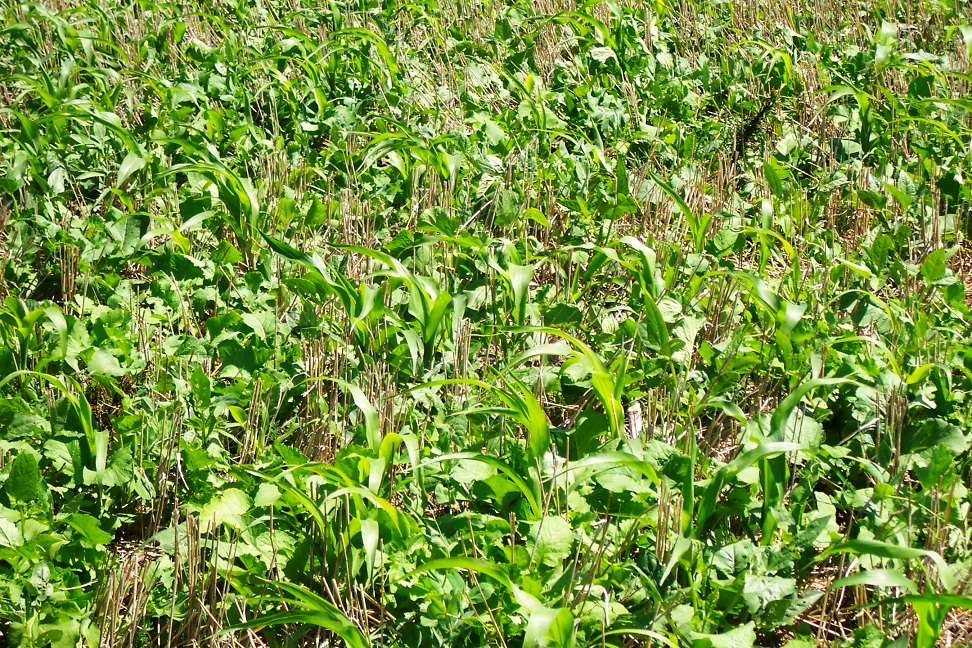
By Amit Jhala, Extension Weed Management Specialist; Daren Redfearn, Extension Forage/Crop Residue Specialist; Bruce Anderson, Extension Forage Specialist; Mary Drewnoski, Beef Systems Specialist; and Chris Proctor, Weed Management Extension Educator
Cover crop adoption is continuing to increase throughout Nebraska. Respondents to the cover crop survey conducted in 2015 during extension meetings in Nebraska indicated the top five desired benefits from cover crops are building soil organic matter, reduced soil erosion, increasing soil water holding capacity, producing forage, improving soil microbial biomass. All of these benefits will improve cropping system productivity and sustainability over time, but it is difficult to determine the direct economic value. For this reason, many producers are using cover crops as a forage crop to offset the expense while still capturing the benefits of cover crops. However, an important consideration when using cover crops for grazing or haying (hereon referred to as forage cover crops) following corn or soybean is that herbicide label rotation restrictions from the agronomic crop MUST be followed because of the potential carryover risk to animals consuming this forage. The recommendations presented in this publication are for forage cover crops as requirements for their integration within an herbicide program are most restrictive.
Most herbicide labels list crop rotation intervals or plant back restrictions that limit how soon a subsequent crop can be planted following an herbicide application. It is important to note that this is different from the grazing or forage restrictions posted on an herbicide label for crops to which an herbicide is directly applied. When planning a fall planted forage cover crop following corn or soybean, a herbicide crop rotation interval or plant back restriction should be short enough to allow the forage cover crop to establish. If the forage cover crop species you intend to plant is not listed on the label, you must follow the rotation restriction listed for “other crops”. In addition, the rotation restriction for a forage cover crop mixture is dictated by the species in the mixture with the longest restriction. Meeting these requirements can be challenging as many forage cover crop species are not listed on herbicide labels and as a result replant restrictions fall outside the ideal fall planting window. Hail or other crop damage, seed corn, and silage corn all provide opportunities for earlier forage cover crop planting; however, herbicide plant back restrictions still must be observed in these situations.
Herbicide persistence in the soil is affected by several environmental factors, and ultimately herbicide residues that can inhibit forage cover crop growth or cause crop failure. Furthermore, herbicide residues can be taken up into forage cover crops and either be directly toxic to livestock or accumulate in their fat, meat, milk, or other tissues and pass into the human food supply. For labeled crops, studies have been conducted to identify safe replant intervals that prevent bioaccumulation of herbicides. In the case of non-labeled crops or ‘other crops’, these tests were not conducted. In this case, labels list the longest plant-back restriction where herbicide companies can be confident potential herbicide carry-over effects are negligible. Without crop specific tests being conducted, the risk for herbicide toxicity to animals consuming cover crop forage or herbicide residues in human food is unknown.
As a point of clarification, if cover crops will NOT be harvested or grazed they could be planted before the label replant restriction allows, but growers must then assume the risk for cover crop failure. However, if the cover crop WILL be used as a forage cover crop, planting before the label replant restriction permits violates federal law. An Environmental Protection Agency (EPA) registered herbicide label is a legal document and must be followed, particularly where human and animal safety is concerned.
Plant back restrictions of forage cover crops will limit herbicides that can be used in corn and soybean cropping systems. Many pre-emergence herbicides that allow fall planting of a forage cover crop have a 4-month restriction interval. To compensate for this, consider planting forage cover crops in the earliest planted, sprayed, and harvested fields. Additionally, to avoid selection for herbicide-resistant weeds due to repeated application of the same herbicide, fields in which forage cover crops are planted should be rotated so that a broader range of herbicides can be used during the non-forage cover crop year.
It can be challenging to decipher herbicide label information when deciding which herbicides to use with forage cover crops. The following tables summarize the replant restrictions for several cool-season and warm-season forage cover crop species where fall planting is feasible and are listed by common pre-emergence and post-emergence corn and soybean herbicides. When tank-mixing herbicides, follow the most restrictive interval listed on all the labels. Integrating forage cover crops into your cropping system can provide economic and agronomic benefits. To maximize these benefits, it is important to consider how your herbicide program might impact the use of forage cover crops in your cropping system.
Herbicide information compiled here (see tables below) is intended to be as accurate as possible at the time of publication; however, refer to current herbicide labels for the latest and most detailed information.
Table 1. Corn Post-emergence Herbicides: http://go.unl.edu/gx2g
Table 2. Corn Pre-emergence Herbicides: http://go.unl.edu/c6e9
Table 3. Soybean Post-emergence Herbicides: http://go.unl.edu/9fyy
Table 4. Soybean Pre-emergence Herbicides: http://go.unl.edu/g5tm
For more material on cover crop termination methods and crop insurance, see the United States Department of Agriculture’s (USDA) Risk Management Agency (RMA) website http://www.rma.usda.gov/help/faq/covercrops2015.html
Disclaimer: Reference to commercial products or trade names in this publication is made with the understanding that no discrimination is intended and no endorsement by Nebraska Extension is implied.
To listen to BeefWatch podcasts go to: https://itunes.apple.com/us/podcast/unl-beefwatch/id964198047 or paste http://feeds.feedburner.com/unlbeefwatch into your podcast app.